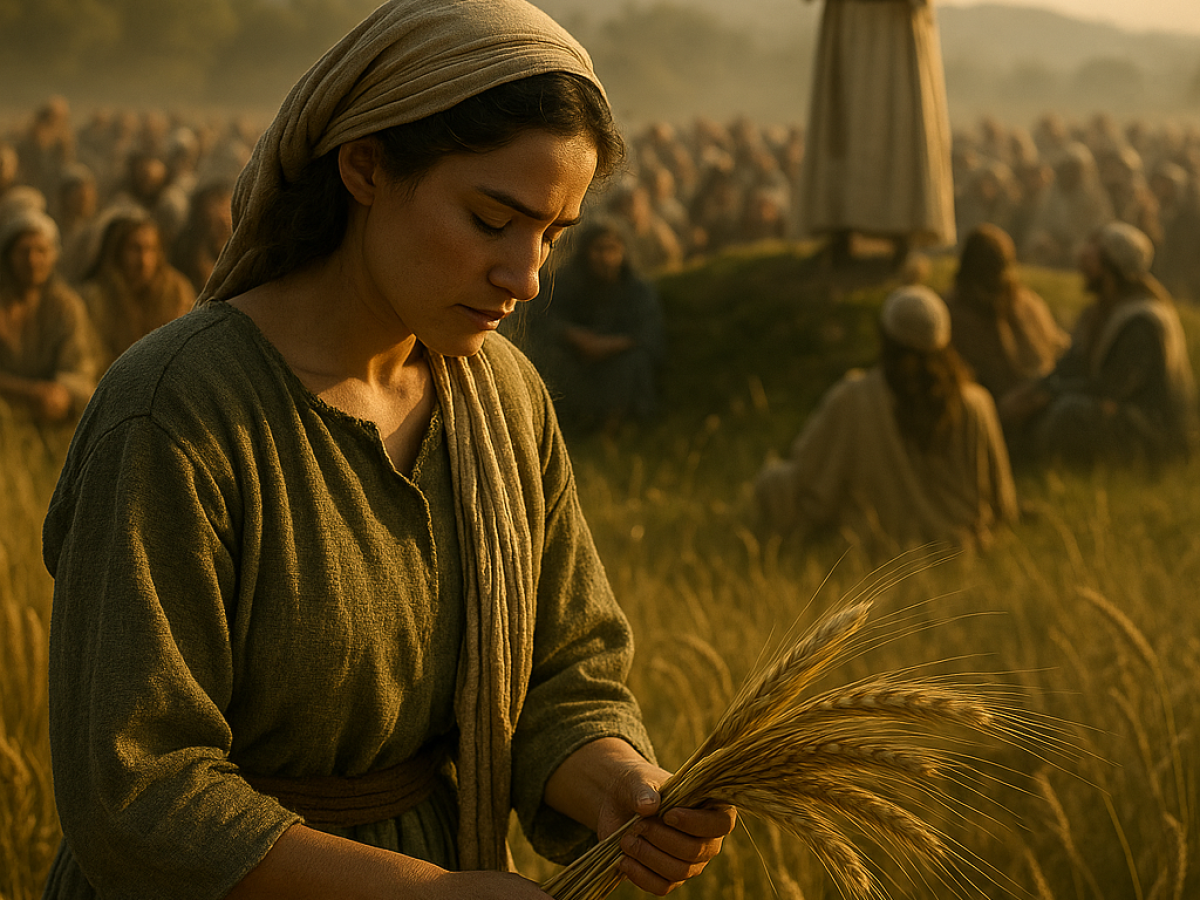
Bread for the Nations: Ruth & the Canaanite Woman
In Matthew’s Gospel, bread becomes a sign of covenant, inclusion, and abundance. When Yeshua feeds the multitudes, He unveils the pattern of God’s redemptive plan through bread — the people eat, are satisfied, and they gather up the leftovers. The two feeding miracles in Matthew, the five thousand and then the four thousand, are not repetitions but rather layers of the kingdom’s expansion—from Israel to the nations. The feedings find their connections to the story of Ruth and the story of the Canaanite woman.
The first feeding (Matt. 14:13–21) unfolds in Jewish territory. Yeshua takes five loaves and two fish, blesses them, breaks them, and feeds the crowd. The five loaves recall the Torah, the covenantal instruction given to Israel, and the twelve baskets of leftovers mirror the twelve tribes. This scene reveals Yeshua not just the new Moses, but a greater Moses, giving heavenly bread to His covenant people in the wilderness. The people eat, are filled, and there are left overs — divine provision for Israel.
Faith That Opens Heaven
Immediately following this miracle, Matthew shares another encounter: the story of the Canaanite woman (Matt. 15:21–28). The geography shifts from Jewish to Gentile territory — from Galilee to the region of Tyre and Sidon by the Mediterranean Sea signaling that something new is about to break open.
The woman who approaches Yeshua is a Canaanite, a descendant of Israel’s ancient enemies, yet she addresses Him with faith: “Son of David, have mercy on me!” Her words stand in stark contrast to Israel’s religious leaders, who question and resist His authority. This Gentile woman recognizes what many in Israel do not — that the promised King of David’s line has come. Her daughter is “severely tormented by a demon,” a haunting image of her nation enslaved to spiritual chaos. Her cry is not only maternal but symbolic: a plea for deliverance from the dominion of darkness.
Yeshua’s reply sounds severe: “I was sent only to the lost sheep of the house of Israel… It is not right to take the children’s bread and throw it to the dogs.” Yet this becomes an invitation for her faith to speak. Like Ruth the Moabitess, humbling herself to glean the fallen grain, this woman kneels and answers, “Even the dogs eat the crumbs that fall from their master’s table.” Her faith has crossed the boundary. Heaven will open, and the bread of heaven will be given to the nations in the feeding of the 4000.
The Table of Ruth and the First Bread of the Nations
The Canaanite woman’s faith is the hinge between the two feedings in Matthew. Immediately after her story comes the feeding of the four thousand (Matt. 15:32–39). The setting is Gentile territory — the Decapolis region east of the Galilee. The symbols tell the story:
- Four evokes imagery of the four corners of the earth — the nations.
- Seven baskets of leftovers recall fullness and completion; savah (“to be satisfied”) shares the same letters as sheva (“seven”).
- The people eat, are satisfied, and there is abundance leftover — but this time it is the nations being filled from Israel’s bread.
Where the first feeding was bread for Israel, this one becomes bread for the nations. Between them stands the faith of a Gentile woman — the bridge from one table to the next.
This pattern reaches back to Ruth. When Ruth, the Moabitess, comes to Bethlehem, the “house of bread,” she asks to glean among the sheaves. She is an outsider seeking mercy, humbling herself to pick up what falls from another’s harvest. Ruth “happens” upon the field of Boaz, the redeemer, whose name means “strength.” At mealtime he invites her, “Come here, eat some bread, and dip your morsel in the wine vinegar.” Ruth sits among the harvesters — a Gentile among Israelites — and “ate until she was satisfied and had some left over.” The language is identical to that used in the feeding of the 5,000 and 4,000 in Matthew.
The echoes are unmistakable: bread, fullness, and leftovers. Boaz commands his reapers to leave extra grain for her, just as Yeshua commands His disciples to gather up the fragments so that nothing is lost. Boaz blesses Ruth: “May the Lord repay your work, and a full reward be given you by the Lord God of Israel, under whose wings you have come for refuge.” Yeshua blesses the Canaanite woman in the same spirit: “Woman, great is your faith!” Her faith is so great — greater even than that of the disciples — that it becomes the catalyst for bread to be poured out upon the Gentiles of that region.
Faith as the Doorway
Ruth and the Canaanite woman mirror one another:
- Both are outsiders who seek refuge under Israel’s God.
- Both approach in humility and perseverance.
- Both receive abundance beyond measure.
Their faith doesn’t steal Israel’s blessing; it multiplies it. Through them, the covenant table widens. The faith of Ruth brought forth King David — and ultimately the Messiah. The Canaanite woman’s faith anticipates the Great Commission in Matthew 28, where the bread of heaven is carried by Yeshua’s disciples to the four corners of the earth. What begins at Israel’s table becomes a feast for the world.
The Mountain of Fullness
In Matthew, both feedings take place on mountains, the meeting points of heaven and earth. Each mountain scene: the Sermon on the Mount, the Transfiguration, and the Great Commission marks a step in the revelation of Yeshua as the Shepherd-King. On this mountain of bread, He conquers not armies but hunger; not enemies but ethnic separation. The seven baskets of fullness (sheva / savah) mark a new creation, bread that satisfies all peoples from the hand of the King of Kings. The faith of outsiders has opened the storehouse of heaven, and the world is filled.
In Yeshua, the Greater Boaz, the Bread of Heaven is broken — first for Israel, then for the nations. Those who come hungry, humble, and believing find themselves seated at His table, filled and satisfied, with abundance left over.
The Expanding Table of the Kingdom
The story of bread in Matthew is the story of covenant expansion — of a table that keeps growing. From Ruth gleaning in Bethlehem’s fields to the Canaanite woman kneeling before Yeshua, the pattern repeats: humility opens favor, faith opens heaven, and bread opens covenant.
The grain gleaned by Ruth become the loaves that feed the nations through the Messiah who came from her line. The loaves are multiplied on Yeshua’s mountain. The covenant meal that began with Israel now extends to all creation — a feast of satisfaction (savah) for every nation, tribe, and tongue. The Bread of Heaven never diminishes when shared — it always multiplies.


Leave a Reply